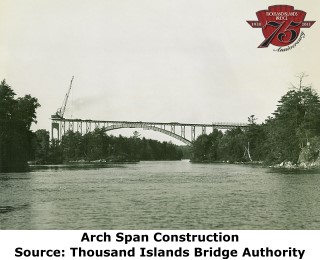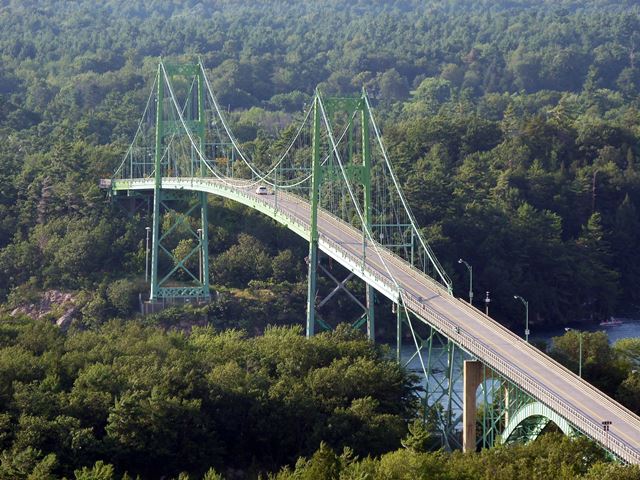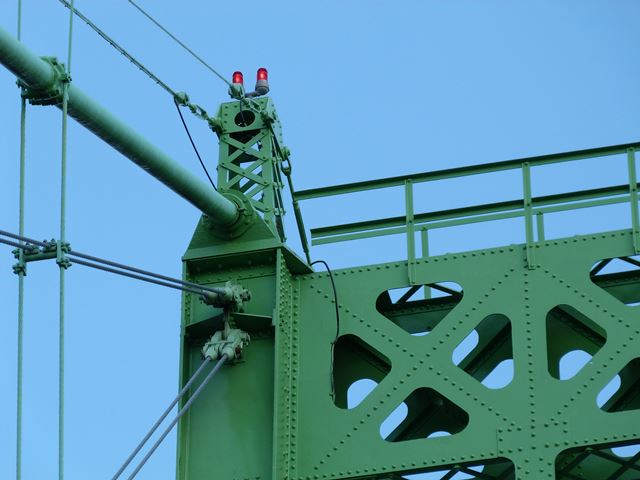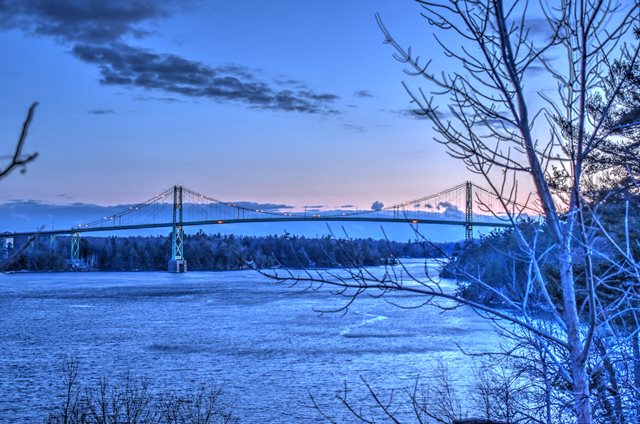We Recommend:
Bach Steel - Experts at historic truss bridge restoration.
BridgeHunter.com Phase 1 is released to the public! - Visit Now
Thousand Islands Bridge
North Channel (Canadian) Bridge

Primary Photographer(s): Nathan Holth and Rick McOmber
Bridge Documented: July 20, 2013 and April 8, 2018
KH-137 Over St. Lawrence River (Fleuve Saint-Laurent) North Channel
Rural: Leeds and Grenville United Counties, Ontario: Canada
1938 By Builder/Contractor: Canadian Bridge Company of Walkerville, Ontario and Engineer/Design: Robinson and Steinman of New York, New York
Not Available or Not Applicable
750.0 Feet (228.6 Meters)
3,330.0 Feet (1015 Meters)
Not Available
3 Main Span(s) and 17 Approach Span(s)
Not Applicable

View Information About HSR Ratings
Bridge Documentation
View Historical Article About This Bridge
Visit The Thousand Islands Bridge Authority Website
View A Report On The Future of the Thousand Islands Bridges
The Thousand Islands Bridge is actually three distinct bridges that hop across islands in the St. Lawrence River. The bridges include the U.S. Bridge, the International Rift Bridge, and the Canadian Bridge. The three bridges are often referred to as a single bridge, but from an engineering standpoint they are clearly three bridges, and as such are represented by separate pages on HistoricBridges.org.
The Canadian Bridge is the most structurally complex of the three bridges, since it is composed of an amazing variety of bridge types. It is almost as if designer David Steinman wished to display all the basic bridge types in a single structure. There are three major bridge spans, with a number of deck plate girder spans mixed in between these spans. From south to north, the major spans include a two span continuous through truss, a steel deck arch, and a suspension structure composed of a traditional three spans.
The bridge's suspension spans are a classic David Steinman suspension bridge. They feature his unique Vierendeel truss towers. Vierendeel refers to the concept of forming a truss using verticals only without diagonal members, and this is visible in a portion of the tower bracing design. Steinman used this design on several bridges he designed. The bridge also features the sleek, shallow plate girder stiffening that is very similar to the Deer Isle Bridge in Maine. Both of these bridges were built in the years leading up to the infamous collapse of the Tacoma Narrows Bridge in Washington in 1940. During these years, engineers, including David Steinman theorized that suspension bridges did not need as much stiffening as had been used in earlier suspension bridges. In some cases, this meant using something more lightweight than a traditional heavy stiffening truss. Instead, Steinman used a shallow plate girder stiffening. When the Tacoma Narrows Bridge collapsed, engineers quickly learned that their theory was incorrect, and that substantial stiffening was needed, bringing an end to the period of minimal stiffening. In response, for the Deer Isle and Thousand Islands Bridge, Steinman's firm was rehired by their owners to retrofit the bridges and protect them from collapse. For both bridges, Steinman's firm designated the addition of cable stays and braces to be added in addition to the suspension system. These cables and bars run from the main cable to the stiffening girder in various places on the bridge. The bridge includes a traditional Steinman detail of a cable bent, where near the ends of the suspension structure, when the main cable is at the deck level, a saddle redirects the cable downward into the anchorage. The central span of the suspension structure is 750 feet (228.6 meters) with 30 panels and the end spans are 300 feet (91.4 meters) with 12 panels.
The bridge's steel arch span is extremely difficult to see and photograph without a boat. It can be seen partially by leaning over the bridge railing, or by viewing the bridge from a nearby observation tower, which affords spectacular views of this bridge and the entire Thousand Islands Bridge system. The steel arch span is solid ribbed and appears to be two-hinged in design. There is no spandrel bracing. The historic integrity appears to be good, with no major structural alterations. The arch span is roughly estimated at 360 feet (109.7 meters)
The continuous through truss spans are variable depth, with the greatest depth over the pier. Locals reportedly call these bridge spans the "cage" referring to the through truss configuration with overhead bracing, that is a lot less open feeling than the other spans on this bridge. The portal and sway bracing appears to be been altered to increase vertical clearance, so the bottom beams on the bracing is not original as a result. The historic integrity is otherwise good. The continuous truss is composed of two 300 foot (91.4 meters) spans with 10 panels each.
The Thousand Islands Bridge celebrated its 75th Anniversary in 2013, and a number of historical photos were released as part of the events by the Thousand Island Bridge Authority. Some of those photos appear on this page.
The future of the Thousand Island Bridges is uncertain. A report released about the bridges recommends the demolition and replacement of the United States bridge in the near term, but leaves the future of the Canadian Bridge uncertain. The report seems to suggest that demolition and replacement of the Canadian span eventually would be preferable to building a second bridge to form a one-way couplet. However, the report is ignorant of the historic significance of these bridges and their impact to an area that is defined by its tourism and beauty. The value of these bridges as such extends far beyond their function. If additional capacity is needed, a one-way couplet solution is the best solution for both bridges.
This bridge is tagged with the following special condition(s): Unorganized Photos
![]()
Photo Galleries and Videos: Thousand Islands Bridge
Structure Overview
Original / Full Size PhotosA collection of overview photos that show the bridge as a whole and general areas of the bridge. This gallery offers photos in the highest available resolution and file size in a touch-friendly popup viewer.
Alternatively, Browse Without Using Viewer
![]()
Structure Details
Original / Full Size PhotosA collection of detail photos that document the parts, construction, and condition of the bridge. This gallery offers photos in the highest available resolution and file size in a touch-friendly popup viewer.
Alternatively, Browse Without Using Viewer
![]()
Structure Overview
Mobile Optimized PhotosA collection of overview photos that show the bridge as a whole and general areas of the bridge. This gallery features data-friendly, fast-loading photos in a touch-friendly popup viewer.
Alternatively, Browse Without Using Viewer
![]()
Structure Details
Mobile Optimized PhotosA collection of detail photos that document the parts, construction, and condition of the bridge. This gallery features data-friendly, fast-loading photos in a touch-friendly popup viewer.
Alternatively, Browse Without Using Viewer
![]()
Additional Unorganized Photos
Original / Full Size PhotosA supplemental collection of photos that are from additional visit(s) to the bridge and have not been organized or captioned. This gallery offers photos in the highest available resolution and file size in a touch-friendly popup viewer.
Alternatively, Browse Without Using Viewer
![]()
Additional Unorganized Photos
Mobile Optimized PhotosA supplemental collection of photos that are from additional visit(s) to the bridge and have not been organized or captioned. This gallery features data-friendly, fast-loading photos in a touch-friendly popup viewer.
Alternatively, Browse Without Using Viewer
![]()
CarCam: Southbound Crossing
Full Motion VideoNote: The downloadable high quality version of this video (available on the video page) is well worth the download since it offers excellent 1080 HD detail and is vastly more impressive than the compressed streaming video. Streaming video of the bridge. Also includes a higher quality downloadable video for greater clarity or offline viewing.
![]()
CarCam: Northbound Crossing
Full Motion VideoNote: The downloadable high quality version of this video (available on the video page) is well worth the download since it offers excellent 1080 HD detail and is vastly more impressive than the compressed streaming video. Streaming video of the bridge. Also includes a higher quality downloadable video for greater clarity or offline viewing.
![]()
Maps and Links: Thousand Islands Bridge
Coordinates (Latitude, Longitude):
Search For Additional Bridge Listings:
Additional Maps:
Google Streetview (If Available)
GeoHack (Additional Links and Coordinates)
Apple Maps (Via DuckDuckGo Search)
Apple Maps (Apple devices only)
Android: Open Location In Your Map or GPS App
Flickr Gallery (Find Nearby Photos)
Wikimedia Commons (Find Nearby Photos)
Directions Via Sygic For Android
Directions Via Sygic For iOS and Android Dolphin Browser












